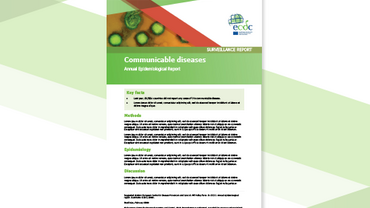Second external quality assessment scheme for Listeria monocytogenes typing
This report presents the results of the second round of the Listeria monocytogenes External Quality Assessment (EQA) scheme for typing of Listeria monocytogenes (further EQA-2). The EQA covers the methods Pulsed Field Gel Electrophoresis (PFGE), conventional serological typing and PCR-based molecular typing. Since 2007, ECDC’s Programme on Food- and Waterborne Diseases and Zoonoses (FWD) has been responsible for the EU-wide surveillance of listeriosis and the detection and investigation of foodborne outbreaks. The objectives of EQA-2 were to assess the quality of PFGE and serotyping and the comparability of the collected test results produced by participating public health national reference laboratories in the European Union (EU), European Economic Area (EEA) and EU candidate countries. A total of 18 laboratories participated in the EQA-2 which took place between October and December 2013.
Executive summary
Listeriosis is a relatively rare but serious foodborne disease, with 1 642 confirmed human cases reported in EU in 2012 (0.41 cases per 100 000). Compared to other foodborne infections under EU surveillance, listeriosis caused the most severe human disease, with 91.6% of the cases hospitalised.
Since 2007, ECDC's programme on Food- and Waterborne Diseases and Zoonoses (FWD) has been responsible for the EU-wide surveillance of listeriosis and facilitation of the detection and investigation of foodborne outbreaks. Surveillance data, including some basic typing parameters for the isolated pathogen, are reported by the Member States to the European Surveillance System (TESSy). In addition to the basic characterisation of the pathogens, there is added public health value in using more advanced and discriminatory typing techniques for surveillance of foodborne infections. In 2012, ECDC initiated a pilot project on enhanced surveillance incorporating molecular typing data into TESSy (TESSy-MSS - ‘molecular surveillance system’).
The objectives of this EQA are to assess the quality of PFGE and serotyping and the comparability of the collected results produced by participating national public health reference laboratories in the European Union (EU), European Economic Area (EEA) and EU candidate countries. Strains for the EQA were selected from strains currently relevant for public health in Europe. A set of ten strains was selected. The set included a broad range of the clinically relevant types for invasive listeriosis.
A total of 18 laboratories participated in at least one part of the EQA-2: 14 laboratories (78%) produced PFGE results, 17 laboratories (94%) participated in the serotyping exercise. Nine of these 17 laboratories performed conventional, phenotypic serotyping, while fourteen performed molecular, PCR-based serotyping.
The majority (86%) of the laboratories were able to produce a PFGE gel of sufficiently high quality to allow for comparison with profiles obtained by other laboratories. The profiles were then normalised and interpreted using the specialised BioNumerics software. Thirteen laboratories completed the gel analysis and generally did so in accordance with the guidelines.
The average score for traditional serotyping among the participants was 78%, a decrease from EQA-1 mainly attributed to one difficult strain. In the molecular (multiplex PCR-based) serotyping participants obtained an average score of 94%.
This EQA-2 scheme for typing of Listeria was the second EQA for laboratories participating in the FWD-Net. Their level of performance in the EQA was encouraging, although the numbers of participants were lower than in EQA-1. The molecular surveillance system being implemented as part of TESSy relies on the capacity of the European Food- and Waterborne Diseases and Zoonoses network (FWD-Net) laboratories to produce comparable typing results. At the moment, the molecular typing method used for EU-wide surveillance is PFGE. Phenotypic serotyping is currently included in TESSy and PCR-based serotyping has been added for 2012. This data is being used for surveillance purposes by several EU countries. In general, countries demonstrated a high proficiency level for serotyping. Two laboratories shifted from the conventional method to the molecular and an additional five laboratories added molecular data to their submission of results. The results of the EQA-2 for PFGE typing of Listeria demonstrate that the majority of participating laboratories were able to produce good results, scoring ‘Fair’ and above in all parameters, which enables inter-laboratory comparisons. Only two laboratories produced results that need to be improved for inter-laboratory exchange of data. However, to achieve an acceptable quality, the technical issues identified could have been overcome by optimising laboratory procedures and providing troubleshooting assistance and training.




